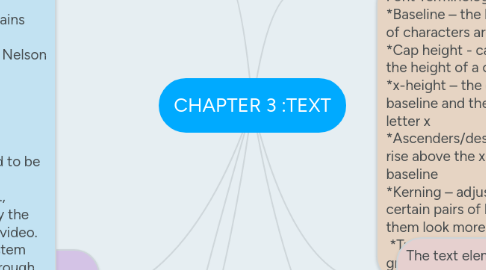CHAPTER 3 :TEXT
von Tew Wen Chun

1. Character sets -Computers can only understand numbers, so an ASCII (American Standard Code for Information Interchange) code is the numerical representation of a character. -Each character is represented by a unique 7-bit binary code word, meaning that there are 128 (2^7) alternative characters.
2. Font Mapping -Some fonts installed in your machine may not be available in other user’s machine. -If the fonts that you used is not available in other people’s computer, a default font will be used for substitution. -Specifying which font to be substitution is called font mapping.
3. Hypertext vs Hypermedia -Hypertext *Hypertext is a text which contains links to other texts. *The term was invented by Ted Nelson around 1965. *Hypertext is the subset of hypermedia. -Hypermedia *Hypermedia is not constrained to be text-based. *It can include other media, e.g., graphics, images, and especially the continuous media – sound and video. (A hypertext or hypermedia system enables the user to navigate through text in a nonlinear way.)
4. Hypertext systems are used for: -Electronic publishing and reference works -Technical documentation -Educational courseware -Interactive kiosks -Electronic catalogs
5. *Text is obviously the simplest of data types and requires the least amount of storage. *Text in the form of symbols, words, sentences, and paragraphs. Text is a vital element of multimedia menus, navigation systems, and content.
6. Font Terminology *Baseline – the line on which the bases of characters are arranged *Cap height - cap height refers to the height of a capital letter *x-height – the distance between the baseline and the top of a lower-case letter x *Ascenders/descenders – strokes that rise above the x-height/drop below the baseline *Kerning – adjustment of space between certain pairs of letters (e.g. AV) to make them look more uniform *Tracking - adjustment of space for groups of letters
7. The text elements used in multimedia are: -Menus for navigation -Interactive buttons -Fields for reading -HTML documents -Symbols and icons


